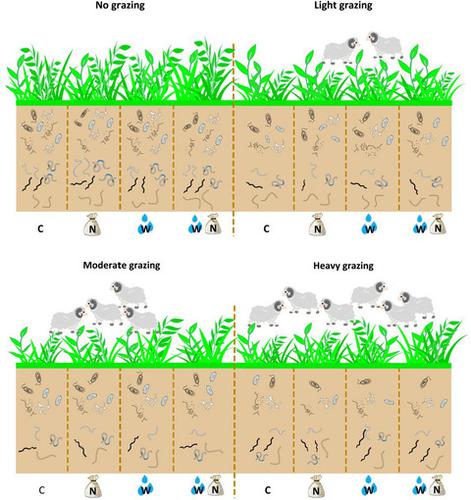当前位置:
X-MOL 学术
›
J. Appl. Ecol.
›
论文详情
Our official English website, www.x-mol.net, welcomes your
feedback! (Note: you will need to create a separate account there.)
Legacy effect of grazing intensity mediates the bottom‐up controls of resource addition on soil food webs
Journal of Applied Ecology ( IF 5.0 ) Pub Date : 2020-12-24 , DOI: 10.1111/1365-2664.13825 Bing Wang 1, 2, 3 , Ying Wu 3, 4, 5 , Dima Chen 3, 4 , Shuijin Hu 6 , Yongfei Bai 1, 2
中文翻译:

放牧强度的遗留效应介导了对土壤食物网的资源增加的自下而上的控制
更新日期:2020-12-24
Journal of Applied Ecology ( IF 5.0 ) Pub Date : 2020-12-24 , DOI: 10.1111/1365-2664.13825 Bing Wang 1, 2, 3 , Ying Wu 3, 4, 5 , Dima Chen 3, 4 , Shuijin Hu 6 , Yongfei Bai 1, 2
Affiliation

|
- Large‐scale studies have demonstrated that nitrogen (N) and water (W) availabilities greatly affect terrestrial ecosystems world‐wide, and this is especially true for the resource‐poor semi‐arid grasslands. Yet, experimental evidence is lacking for how N and W availabilities affect soil food webs across historical grazing intensity‐altered environments at a local scale.
- Here, we included N‐ and W‐addition treatments in an 8‐year grazing experiment (with four grazing intensities) to determine how the legacy effects of grazing intensity mediate the responses of key components of soil food webs (plants, micro‐organisms and nematodes) to resource addition in a semi‐arid grassland.
- After 4 years of N‐ and W‐addition treatments (with no grazing during that 4‐year period), we found that a legacy of grazing, even light grazing, had significant negative effects on the components of plant community and soil food webs. Both N and W addition increased above‐ and below‐ground plant biomass, especially under moderate and heavy grazing. N addition had negative effects on the biomass of bacteria under no grazing, while W addition increased the biomass of actinomycetes under light grazing. N addition decreased the abundance of omnivorous + carnivorous nematodes under light and heavy grazing, while W addition increased their abundance under heavy grazing. Overall, the effects of resource addition on soil food webs progressively decreased from the lowest trophic level (primary producers, i.e. plants), to intermediate trophic levels (micro‐organisms and root‐feeding nematodes), to higher trophic levels (microbial‐feeding nematodes and omnivorous + carnivorous nematodes).
- Synthesis and applications. Our results, which are the first data concerning the effects of resource addition on key components of soil food webs across a historical grazing‐induced environmental gradient, show that the strong bottom‐up controls of resource addition on soil food webs are mediated by the legacy of grazing intensity. These findings should be useful for predicting the responses of grassland ecosystems to future climate change and suggest that the recovery of degraded grasslands will require more than restoration measure of resource inputs alone.
中文翻译:

放牧强度的遗留效应介导了对土壤食物网的资源增加的自下而上的控制
- 大规模研究表明,氮(N)和水(W)的利用率极大地影响了全世界的陆地生态系统,对于资源贫乏的半干旱草原尤其如此。然而,缺乏实验证据表明在局部规模上,在历史放牧强度改变的环境中,氮和磷的有效性如何影响土壤食物网。
- 在这里,我们在一项为期8年的放牧实验(具有四个放牧强度)中包括了N和W加成处理,以确定放牧强度的遗留效应如何介导土壤食物网的关键成分(植物,微生物和土壤)的响应。线虫)在半干旱草地上增加资源。
- 经过4年的N和W加肥处理(在这4年中没有放牧),我们发现放牧(甚至是轻度放牧)对植物群落和土壤食物网的组成具有显着的负面影响。氮和磷的添加均增加了地上和地下植物的生物量,尤其是在中度和重度放牧条件下。在放牧条件下,氮的添加对细菌的生物量具有负面影响,而在轻放牧条件下,W的添加增加了放线菌的生物量。在轻度和重度放牧条件下,添加N会降低杂食性和肉食性线虫的丰度,而在重度放牧条件下,W添加会增加其丰富度。总体而言,资源增加对土壤食物网的影响从最低营养水平(主要生产者,即植物)开始逐渐降低,
- 综合与应用。我们的结果是关于在历史放牧引起的环境梯度上资源添加对土壤食物网的关键组成部分的影响的第一批数据,表明我们对土壤食物网资源添加的强大的自下而上控制是由遗产控制的。放牧强度 这些发现对于预测草地生态系统对未来气候变化的反应应该是有用的,并且表明退化草地的恢复将需要的不仅仅是恢复资源投入的措施。











































 京公网安备 11010802027423号
京公网安备 11010802027423号